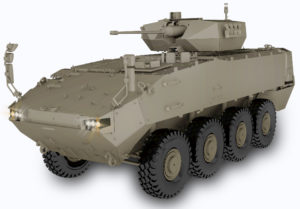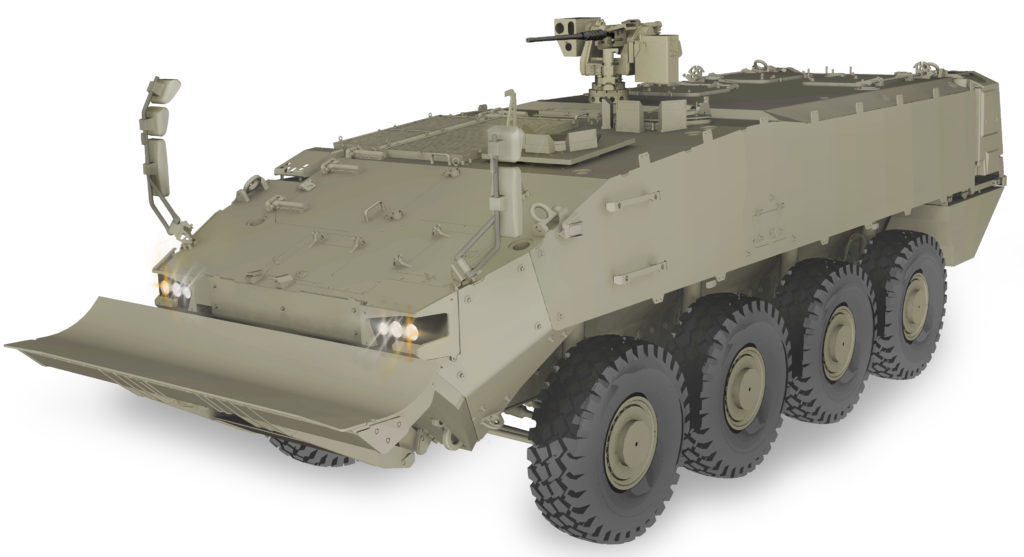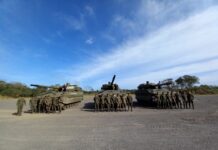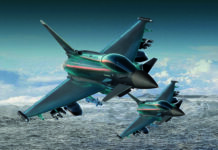The Spanish MoD shocked the industry last Christmas by rejecting the offer of GDELS-SBS. A new public tender is to be announced in the course of this 2020.
Waiting and waiting could still be the headline of the story about the future 8×8 armoured fighting vehicle for the Spanish Army, the so-called DRAGÓN project.
The last, surprising news came unexpectedly on 23 December 2019, when the Spanish Ministry of Defence refused to accept the offer of General Dynamics European Land Systems-Santa Bárbara Sistemas (GDELS-SBS) to produce a first batch of 348 vehicles in the scope of a €2,083M contract, covering the 2019 to 2030 fiscal periods.
The MoD stated that “the offer does not prove the unconditional acceptance of the requirements of the technical specification”. In addition, “the offer presented by GDELS-SBS does not include any economic item associated with risks so that the programme could require more budget”.
It has been made public that the budget rise by another 25% if so required. But the Government invests efforts to avoid an increased budget requirement.
After this decision, the acting Minister of Defence, Margarita Robles, announced that the Government would make the contract subject to competition. “It will be an open public international tender”, the minister said. Previously, the contract was awarded to Santa Bárbara under the terms of a procedure excluding other contenders, which is based on a legal exception for matters related to national security.
According to some industrial sources, “the decision to cancel the contract is interpreted as a step towards obtaining a new and better offer from GDELS-SBS or redefining the capabilities of the vehicle rather than the end of the project”.
The BOXER – an Option?
Therefore, other companies like the French Nexter (VBCI vehicle), the Italian Iveco (FRECCIA) or the German-Dutch ARTEC consortium (BOXER) could become contenders for the new contract that the Spanish Government has announced, to send RfPs for this year.
The ARTEC option could be interesting for Spain since it is an OCCAR programme. In December 2006, OCCAR awarded the contract for the series production of 272 vehicles for Germany and 200 vehicles for the Netherlands to ARTEC, a consortium of Krauss-Maffei Wegmann, Rheinmetall Landsysteme and Rheinmetall Nederland, the former Stork PWV. The BOXER for Germany currently comes in four different vehicle versions. The Netherlands have ordered five different versions. Lithuania joined the BOXER programme in August 2016 to procure 89 IFVs. On 4 November 2019, the OCCAR-EA Director and the ARTEC Chief Executive Officers signed a contract for the procurement of more than 500 BOXER vehicles on behalf of the United Kingdom of Great Britain and Northern Ireland (UK).
As was to be expected, GDELS-SBS has been justifying its bid by stating that “It responds both to the technical demands outlined in the specifications and to the economic requirements. We understand that the problem is insufficient budget to cover the scope and solutions defined in the specifications. Santa Bárbara Sistemas will continue to look for alternatives to obtain the 8×8 VCR contract and is prepared to guarantee the most competitive bid possible in any tender.”
“The proposal is backed by the company’s extensive experience in the design and manufacture of wheeled and tracked armoured vehicles, with more than 11,000 PIRANHAs in different variants contracted in many countries”, the company said in an official statement.


The background to this project is very complicated. After some delays, the Spanish Government authorised the contract signature for the manufacture of the DRAGÓN with General Dynamics European Land Systems (GDELS) as the prime contractor and technical integration authority in July 2019.
The Spanish companies Indra (systems integration) and Sapa (transmission) were selected as main partners. However, there will be no contract signature in January 2020, as originally scheduled.
“This contract will include a schedule of vehicle deliveries that will meet the objectives set by the defence administration according to the deadlines planned so far, which means that the first pre-series DRAGÓNs are to be delivered towards the end of 2021”.
13 Different Configurations
According to official documents, Spain plans to acquire a first batch of 348 DRAGÓN vehicles in 13 different configurations under the terms of a €2,083M contract, covering the 2019 to 2030 fiscal years. This includes the components of the mission system (armament, protection level, sensors, communication, and command and control systems) as well as the logistic support elements derived from logistic support analysis.
In the other acquisition phases, the total number of units for the Spanish Army may be around 1,000 within a total budget of €3,800M – €1,600M for the acquisition itself and €2,200M for the maintenance and modernisation services during the 30 year life of the project.
However, this was the theory. After the delays, the Spanish Army may reconsider the total number of vehicles given that the operational conditions for military deployments abroad might change.
Background: The Attack in Lebanon
After an attack in Lebanon – in which six soldiers died – the contract that is now authorised had its antecedent in a Council of Ministers decision (dated 2 November 2007), which approved the ‘Plan for the Renewal of Armed Forces Materiel’. This agreement included the need to purchase an armoured vehicle on wheels, replacing the obsolete BMR 6×6 wheeled armoured personnel carrier. The programme was interrupted due to lack of funding for the crisis. “Its objective is to replace, in a progressive way, the historical BMR, TOA and VEC, and the vehicles used for the protection against mines and improvised explosive devices, such as the LINCE and the RG-31”, an Army official explained.
What about the Demonstrators?
Another problem faced by the project is the fact that the Army was unable to provide the technical requirements for the five demonstrators – a demand of the Chief of the Army General Staff, General Francisco Javier Varela and a clear condition for the Spanish Army, that wanted to conclude the operational evaluation this year, which is now scheduled to begin on 2 July 2020 and will last for some five months. “This date could still undergo further modifications”, official sources told ESD. The Legion, located in Almería (southeast Spain), is the military unit designated for the experimental tests.
For these demonstrators, an initial budget of €92M was allocated for GDELS, Indra and Sapa as a joint venture. That contract was awarded separately from the production order.
Capabilities to be provided by the five prototypes have been identified by the Spanish Army as follows:
- D1: Basic vehicle: remote control weapon station with a 30mm gun;
- D2: Section command post with manned turret with 30 mm gun;
- D3: Company command post as an armoured platform with remote-controlled turret integrating a 30mm gun;
- D4: Engineer vehicle with a remote-controlled weapon station with a 12.7 mm machine gun;
- D5: Forward artillery observer with a remote-controlled weapon station with a 12.7 mm machine gun.
- From a technology point of view, the demonstrators should also consider:
- An increase in safety: a laser lighting alert system, acoustic fire detection, a protection kit against RPG, add-on armour for ballistic protection against mines and IEDs; bulldozer IED clearing device.
- 360° situational awareness using panoramic cameras, driving support with two infrared cameras (at the front and at the back).
- Integrated communication and information services (CIS) with systems at squad/section/company level, vehicle electronics;
- Propulsion system: DC13 engine from Scania; SAPA SW624 transmission;
- Forward observer: stabilised sensor platform on a flying mast; portable sensor system.
Made in Spain
For the Spanish MoD, it is essential that the DRAGÓN is a “made in Spain” vehicle with future export potential. “It will have an impact on the Spanish industrial base obtaining a national product, integrated in, and with the design authority in Spain”, an official MoD source told ESD. This is a lesson learnt from the LEOPARD 2 main battle tank programme, which could not be sold to Saudi Arabia due to the German Government’s export restrictions.
In total, it is estimated that the production of the new armoured vehicle will generate some 650 jobs, and a further 1,000 indirect jobs should GDELS-SBS be chosen as the prime contractor in response to the new RfP.
The name DRAGÓN evokes the military virtues of the former Dragoon units, a mixture of Infantry and Cavalry, predecessors of the current units.
The Battle for the Turrets
As the kind of armament the vehicles will be equipped with which is yet to be decided, a battle is going on between the bidders of the turret systems for the ATK MK44-ABM BUSHMASTER II chain gun. The two main Israeli land defence companies, Elbit Systems and Rafael, displayed their turrets during the first edition of the Spanish International Defence and Security Fair (Feindef) held in May 2019 in Madrid.
The reasonis the lucrative contract to arm the DRAGÓN, whose programme includes an initial phase of 348 vehicles: 190 units will be armed with an unmanned turret of 30 mm. This second-level contract is valued at €350M. This competition between the two Israeli companies has generated a number of synergies and alliances with Spanish companies. “There is an unwritten rule there must be a technological and employment return in the country that is bidding the contract.”, retired Brigadier General and Vice President of Rafael, Michael Lurie, told ESD. For this ‘Spanishisation’, Rafael is presenting its turret through its subsidiary company in Madrid, Pap Tecnos, which has no production factory in Spain. However, Rafael has also established communications with another Spanish company, Tecnobit, that could be added to the business as it does have a production plant.
The SAMSON MK-II unmanned turret is the Rafael option for the DRAGÓN: “It is lighter than manned turrets and does not require penetration into the vehicle hull, saving significant interior space. The in-hull reloading system boosts crew survivability, and the low silhouette enables the platform’s surfaces to easily accommodate protective armour. An anti-tank guided missile launcher and smoke grenade launcher are also optional”.
Rafael is a state-owned company from Israel that was established as a military technology “laboratory”. “If we win the contract, Tecnobit will also be a production partner for future exports,” Lurie said.

On the other hand, Elbit Systems has entered into an alliance with Navantia (100% Spanish state-owned company). Both companies presented the TIZONA unmanned 30 mm turret at FEINDEF (TIZONA is the name of a sword of “El Cid”, the Spanish medieval national hero).
The Spanish company Expal is also part of the team. The objective of Navantia is to “diversify” its business, beyond shipbuilding, and enter the subsector of systems integration of land platforms.
The Italian company Leonardo has been the third foreign contender, bidding in a partnership with the Spanish Escribano and Indra.
Another contender is the Belgian company John Cockerill Defense, recently re-branded from CMI Defense. The company has an established footprint in Madrid and is already delivering projects with Spanish partners, including Albengoa Inovació, SDLE and Itainnova. The company offers its 3000 Series modular turret system, and is in the process of establishing a production facility in southern Spain with another major Spanish defence company. In addition to both manned and unmanned alternatives, through careful design the 3000 series offers significant cost benefits in terms of price, production, training and maintenance. (See box-out, page 68.)
In addition, the technology demonstrator used to study systems integration considers three weapon stations: the 12.7 mm GUARDIAN remote-controlled weapon station (RCWS) from Escribano and Rafael’s 12.7 mm MINI SAMSON RCWS (believed to be the favoured solution in this category). Last but not least, the 30 mm HITFIST manned turret from Oto Melara may have already been chosen.
Esteban Villarejo











